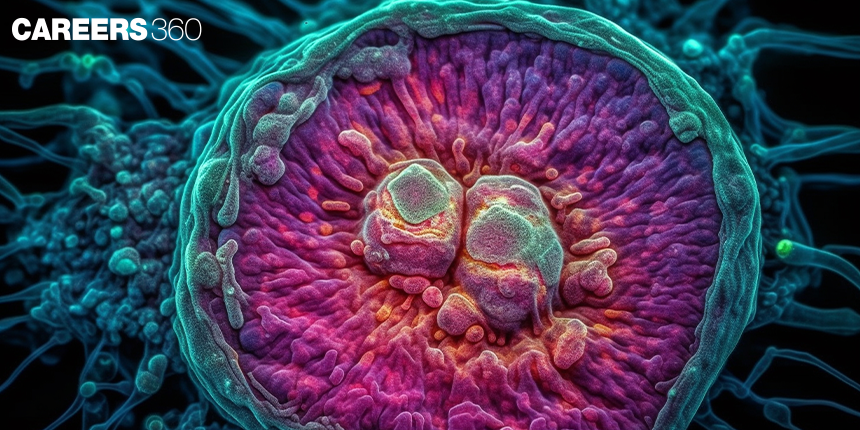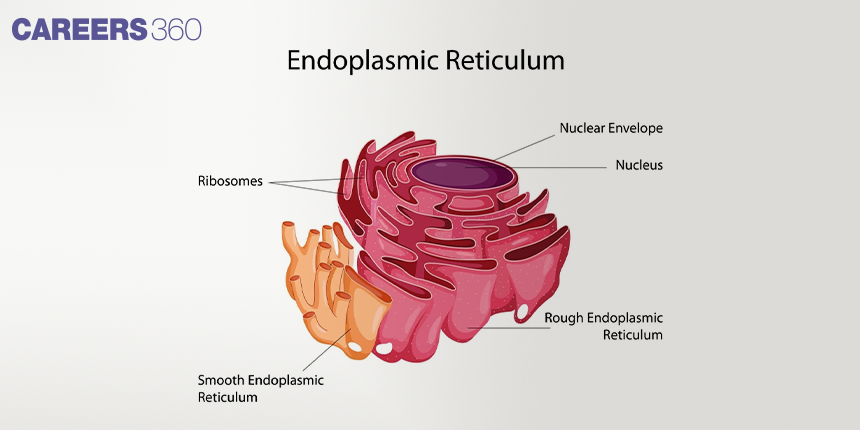Endoplasmic Reticulum: Definition, Types, Examples, Diagram, Function
The endoplasmic reticulum (ER) is a network of membranous tubules within the cytoplasm of a eukaryotic cell that is involved in protein and lipid synthesis. There are two kinds- Rough Endoplasmic Reticulum and Smooth Endoplasmic Reticulum. Endoplasmic reticulum is a topic of the chapter Cell: The Unit of Life in Biology.
NEET 2025: Mock Test Series | Syllabus | High Scoring Topics | PYQs
NEET Important PYQ's Subject wise: Physics | Chemistry | Biology
New: Meet Careers360 B.Tech/NEET Experts in your City | Book your Seat now
- What is the Endoplasmic Reticulum?
- Endoplasmic Reticulum Structure
- Types of Endoplasmic Reticulum
- Endoplasmic Reticulum Function
- Biogenesis and Maintenance of the ER
- Applications and Relevance
- Recommended video for Endoplasmic Reticulum

What is the Endoplasmic Reticulum?
The endoplasmic reticulum is defined as a complex network of membranous tubules and sacs in the cytoplasm of eukaryotic cells. The ER can be further divided into two regions. The rough ER is studded with ribosomes and mainly engaged in the synthesis of proteins. The smooth ER is associated with lipid synthesis. It sends the newly synthesized proteins and lipids within the cell to their right destinations within the cell or out of it.
The discovery of endoplasmic reticulum dates back to the 1940s, with the help of an electron microscope. The more significant contributions are observed to have been made first by Keith Porter, Albert Claude, and Ernest Fullam. Their work on this area of cell structure led to the initial periods of knowing about this component of cells.
The diagram shows the structure and position of both the Smooth Endoplasmic Reticulum and the Rough Endoplasmic Reticulum.

Endoplasmic Reticulum Structure
The structure of the endoplasmic reticulum is described below-
The endoplasmic reticulum is a single, continuous membrane system composed of a network of flattened sacs, tubules, and vesicles.
The lumen is the space enclosed within the ER membrane and is different from the cytosol.
The rough endoplasmic reticulum contains many ribosomes that are studded over the surface and are, therefore, involved in protein synthesis.
The smooth ER is unattached with ribosomes and is therefore involved in lipid synthesis and cellular detoxification.
The ER carries an extended and dynamic membrane system, therefore guaranteeing that intracellular communication and transport are performed efficiently.
Also read-
Types of Endoplasmic Reticulum
The endoplasmic Reticulum is divided into two types:
Rough Endoplasmic Reticulum (RER)
The surface of the RER is rough because of ribosomes scattered over its cytoplasmic aspect.
Protein synthesis takes place in these ribosomes.
The RER consists of a series of flattened membrane sacs, called cisterns, with connecting tubules.
This supports the effective processing of proteins destined for secretion, insertion into the membrane, or targeting to lysosomes.
Smooth Endoplasmic Reticulum (SER)
The smooth endoplasmic reticulum appears smooth because there are no ribosomal subunits overlaying its cytoplasmic surface.
The principal functions are lipid synthesis, carbohydrate metabolism, drug detoxification, and calcium ion storage.
In muscle cells, the SER is differentiated further as the sarcoplasmic reticulum.
Endoplasmic Reticulum Function
Certain functions of the endplasmic reticulum (RER and SER) are discussed :
Functions of Rough Endoplasmic Reticulum (RER)
The Rough Endoplasmic Reticulum (RER) is an important component of the protein synthesis system because ribosomes decode mRNA molecules into polypeptides on its surface.
The nascent proteins are discharged into the lumen of the RER for folding and a number of quality control processes to ensure their accuracy in conformation.
The RER also participates in the system of glycosylation, a process where carbohydrate groups are added to proteins to ensure the stability and functionality of proteins.
Functions of Smooth Endoplasmic Reticulum (SER)
The main function of smooth endoplasmic reticulum (SER) is to synthesise lipids which form part of the cell membrane.
It is also involved in the carbohydrate metabolism that converts glucose-6-phosphate to glucose.
The SER is involved with detoxifying drugs and poisons because it chemically changes them into more water-soluble compounds that can be excreted.
The SER is also a store for calcium ions that, on its release into the cytoplasm, function to turn on various cellular processes, including muscle contraction.
Dynamics and Regulation of the ER
The dynamic activity of the endoplasmic reticulum in view of maintaining cellular homeostasis is thoroughly regulated.
The unfolded protein response or UPR results are due to ER stress arising from misfolded or unfolded proteins accumulating in the lumen of the ER.
In normal function restoration, this compound blocks the translation of proteins, degrades misfolded proteins, and upregulates the signal pathways.
It is an important response in the maintenance of health and activity of the cell and prevents diseases caused by misfolded proteins.
The ER is a highly interrelated organelle with Golgi apparatus, lysosomes, and plasma membrane, and it majorly plays a role in vesicle formation.
It facilitates the transport of the synthesized proteins and lipids to the Golgi apparatus for further processing and sorting.
It also provides for the manufacture and transport of vesicles to other organelles, such as lysosomes and the plasma membrane.
Biogenesis and Maintenance of the ER
The biogenesis of the ER is traced back to early cell development. The ER is developed and altered through genetic control by specific genes and proteins. These drive the synthesis of the membrane and its further expansion. Due to the dynamic properties of ER development, its structure and function are moulded based on the cell's physiological demands.
The maintenance of the Endoplasmic reticulum is maintained by the continuous occurrence of reorganisations of the membrane, which are orchestrated through selective autophagy, known as reticulophagy, and the ERAD pathway. ERAD makes sure that the organelle is continually robust and efficient to meet the requirements of the cell in protein and lipid synthesis, folding, and transport.
Applications and Relevance
The use of the ER is much greater in the field of medicine and biotechnology. It helps in understanding the pathological mechanisms of neurodegenerative diseases and diabetes, where stress in the endoplasmic reticulum and misfolded proteins are very important.
Knowledge about ER functions and its stress-related responses will help design possible drugs and genetic engineering to restore or repair homeostatic imbalances. In cellular and molecular biology, the ER is an extremely important part because understanding the synthesis of proteins and lipids, their intracellular transport, and the intricate regulation of cell functions is very crucial.
Also Read-
Recommended video for Endoplasmic Reticulum
Frequently Asked Questions (FAQs)
The endoplasmic reticulum of the eukaryotic cell is a membranous network of tubules, and sacs are associated with protein and syntheses of lipids.
There are two types of ER: rough ER, which has ribosomes attached and is involved in protein synthesis, and smooth ER, which lacks ribosomes and is involved in lipid synthesis and detoxification.
Endoplasmic Reticulum synthesizes, folds, modifies, and transports both lipids and proteins in the cell.
Rough ER is the type of ER that permits ribosomes on the surface for the synthesis of proteins, and smooth ER is linked to the synthesis of lipids and the detoxification process but cannot permit the ribosome.
The rough endoplasmic reticulum helps in the synthesis of proteins by the ribosome and also in their proper folding and modification.
The smooth endoplasmic reticulum detoxifies drugs and poisons by the modification process to excrete out of the body as water-soluble compounds.
ER stress results from misfolded protein aggregation, which triggers the cells' unfolded responses to try and restore homeostasis. The response is such because if the stress is continued, the cell is damaged, thereby initiating disease.
Also Read
27 Dec'24 05:51 PM
23 Nov'24 05:46 PM
08 Nov'24 05:04 PM
08 Nov'24 10:59 AM
08 Nov'24 09:54 AM
08 Nov'24 09:26 AM
08 Nov'24 09:01 AM
07 Nov'24 10:17 PM
07 Nov'24 09:50 PM
07 Nov'24 04:38 PM